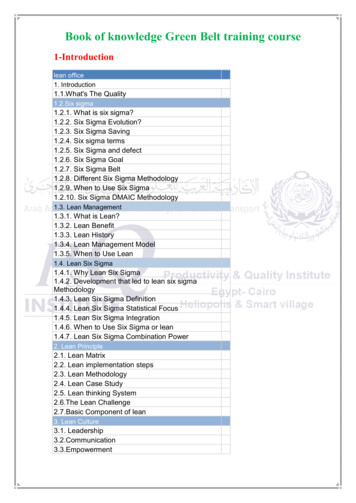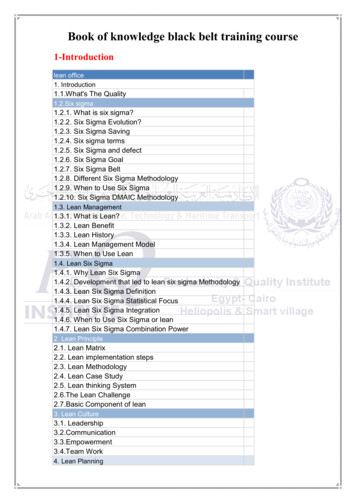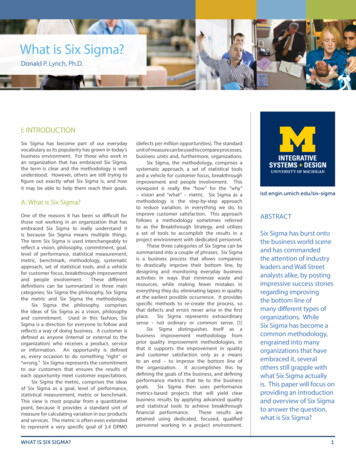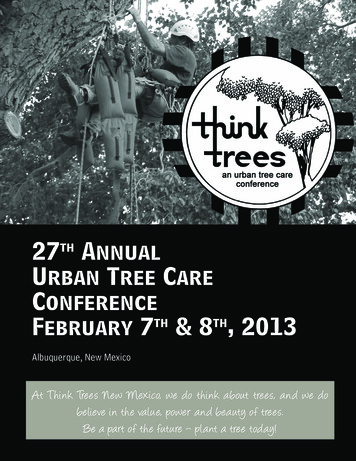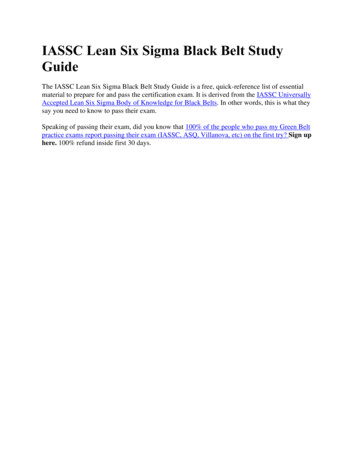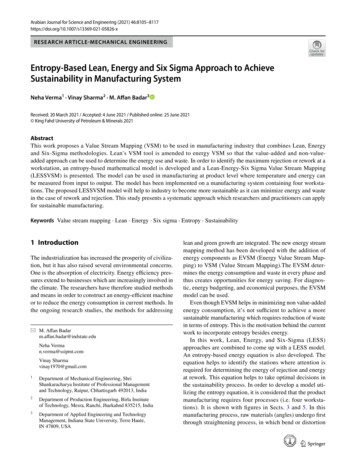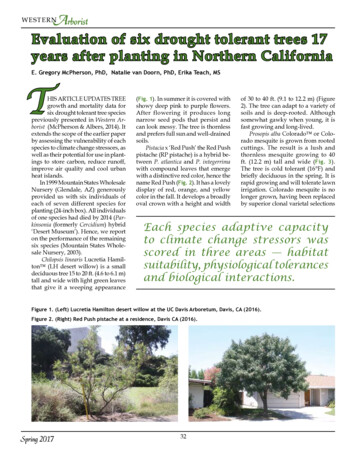
Transcription
ArboristEvaluation of six drought tolerant trees 17years after planting in Northern CaliforniaW E S TERNE. Gregory McPherson, PhD, Natalie van Doorn, PhD, Erika Teach, MSThis article updates treegrowth and mortality data forsix drought tolerant tree speciespreviously presented in Western Arborist (McPherson & Albers, 2014). Itextends the scope of the earlier paperby assessing the vulnerability of eachspecies to climate change stressors, aswell as their potential for use in plantings to store carbon, reduce runoff,improve air quality and cool urbanheat islands.In 1999 Mountain States WholesaleNursery (Glendale, AZ) generouslyprovided us with six individuals ofeach of seven different species forplanting (24-inch box). All individualsof one species had died by 2014 (Parkinsonia (formerly Cercidium) hybrid‘Desert Museum’). Hence, we reporton the performance of the remainingsix species (Mountain States Wholesale Nursery, 2003).Chilopsis linearis Lucretia Hamilton (LH desert willow) is a smalldeciduous tree 15 to 20 ft. (4.6 to 6.1 m)tall and wide with light green leavesthat give it a weeping appearance(Fig. 1). In summer it is covered withshowy deep pink to purple flowers.After flowering it produces longnarrow seed pods that persist andcan look messy. The tree is thornlessand prefers full sun and well-drainedsoils.Pistacia x ‘Red Push’ the Red Pushpistache (RP pistache) is a hybrid between P. atlantica and P. integerrimawith compound leaves that emergewith a distinctive red color, hence thename Red Push (Fig. 2). It has a lovelydisplay of red, orange, and yellowcolor in the fall. It develops a broadlyoval crown with a height and widthof 30 to 40 ft. (9.1 to 12.2 m) (Figure2). The tree can adapt to a variety ofsoils and is deep-rooted. Althoughsomewhat gawky when young, it isfast growing and long-lived.Prosopis alba Colorado or Colorado mesquite is grown from rootedcuttings. The result is a lush andthornless mesquite growing to 40ft. (12.2 m) tall and wide (Fig. 3).The tree is cold tolerant (16 F) andbriefly deciduous in the spring. It israpid growing and will tolerate lawnirrigation. Colorado mesquite is nolonger grown, having been replacedby superior clonal varietal selectionsEach species adaptive capacityto climate change stressors wasscored in three areas — habitatsuitability, physiological tolerancesand biological interactions.Figure 1. (Left) Lucretia Hamilton desert willow at the UC Davis Arboretum, Davis, CA (2016).Figure 2. (Right) Red Push pistache at a residence, Davis CA (2016).Spring 201732
ArboristWESTERNFigure 3. (Left) Without pruning, this Colorado mesquite in Davis, CA has developed low branches to shade the surroundingsoil (2016).Figure 4. (Right) Texas red oak in a Sacramento, CA park setting (2016).such as PhoenixTM and MaverickTM.Quercus buckleyi (syn. Q. texana) orTexas red oak is a drought tolerantwest Texas native found growing inthe hill country west of San Antonioand closely related to the Shumardoak (Quercus shumardii). It is a deciduous tree that grows 30 to 40 ft. (9.1 to12.2 m) tall and wide with a dense,upright crown that becomes roundedwith age (Fig. 4). The leaves are classicoak with five prominent lobes, darkgreen and shiny on top, paler below.They turn burgundy to brilliant scarlet in the fall.Quercus fusiformis or escarpmentlive oak is native to alkaline soils inwest Texas. This cold-hardy evergreen grows 40 to 50 ft. (12.2 to 15.2m) tall and wide and its thick crownprovides dense shade ( Fig. 5 ). Itssmall leaves resemble southern liveoak (Quercus virginiana), with whichit hybridizes (Fig. 6). However, it ismuch more tolerant of high temperatures and drought.Quercus muhlenbergii or chinquapin oak comes from seed collectedin west Texas from smaller growingtrees than relatives in the southeasternU.S. It grows to 30 to 40 ft. (9.1 to 12.2m) tall and wide, forming a long-livedshade tree (Figure 6). Its crinkly, lushgreen leaves are deciduous and turnorange to bronze in the fall. It preferswell-drained soil and grows surprisingly fast, even in desert heat.The trees are now 17 years old andour focus is on the trees remaining inSacramento and Davis locations: Reichmuth Park in Sacramento,CA – south end of the park, moderate use area, poorly irrigated turf. Northstar Park in Davis, CA – ina planting bed adjacent to the soccerfield, initial irrigation. UC Davis Arboretum andDepartment of EnvironmentalHorticulture grounds – in plantingbeds and well-irrigated turf that hasbeen converted to unirrigated nativegrassland. UC Davis Orchard Park – drygrass area adjacent to parking,minimal, if any, maintenance andirrigation. Two residential landscapes inDavis, CA – in a front yard with irrigated turf and areas mulched withshredded bark or decomposed granite that received very little irrigationafter establishment.Trees were surveyed annuallyfrom 2000 to 2009 and in 2013 and2016. Tree growth is reported basedon measurements of diameter atFigure 5. (Left) Escarpment live oakin the UC Davis Shields Oak Grove(2016).Figure 6. (Right) Chinquapin oak in theUC Davis Shields Oak Grove (2013).33Spring 2017
ArboristW E S TERNTable 1. Survival after 17 yearsSpeciesAliveDeadTotalSurvivalLH Desert Willow22450%RP Pistache22450%Colorado Mesquite31475%Texas Red Oak505100%Escarpment Live Oak22450%Chinquapin Oak505100%TOTAL1972673%Table 2. Mean sizes and standard errors (SE) at 17 years ELH Desert Willow3.80.2111.80.3310.91.39RP Pistache12.70.4924.62.3029.05.50Colorado Mesquite14.33.8027.61.9738.63.15Texas Red Oak11.01.6831.52.9430.43.30Escarpment Live Oak14.50.0229.26.2340.56.89Chinquapin Oak10.50.9634.33.3926.62.82breast height (to nearest 0.1 cm withdbh tape), tree height (to nearest 0.1m with range pole or hypsometer)and average crown diameter (averageof two perpendicular measurementswith tape to the nearest 0.1 m). Survival was calculated as the percentageof live trees after 17 years.Each species adaptive capacity toclimate change stressors was scoredin three areas: habitat suitability,physiological tolerances and biological interactions (Bagne et al., 2011).A rating of -1, 0, or 1 (intolerant, neutral, tolerant) was assigned for eachfactor, as reported in the literature(McPherson et al., In Review). Scoreswere summed with higher scoresindicating less vulnerability. It wasdifficult to score some species becausedata were lacking. Uncertainty wasquantified as the percentage of factors scored. Data sources includedSelecTree (https://selectree.calpoly.edu/), Water Use Classificationof Landscape Species (WUCOLS)(Costello & Jones, 2014), Wu andDodge (2005) and the California Invasive Plant Council (http://www.cal-ipc.org/). The potential for eachspecies to produce selected ecosystemservices, such as cool urban heat islands, reduce stormwater runoff, improve air quality and store carbon wasassessed subjectively, based on datafrom the literature and our observations. The availability of each specieswas determined by contacting nurseries that serve the Sacramento area, aswell as the SelectTree database.ResultsSurvival: Nineteen (73%) of thetwenty-six trees planted were aliveafter 17 years (Table 1). The Texas redoak and chinquapin oak experiencedzero mortality. The survival rate forthe Colorado mesquite was 75% and50% for the desert willow, Red Pushpistache and escarpment live oak.Growth: After 17 years the meanheight of the three oaks ranged fromabout 30 to 35 feet (Table 2). Meancrown diameter was greater thanheight for the escarpment live oak.Chinquapin oak was more upright,while crown spread and tree heightwere nearly equal for the Texas redTable 3. Vulnerability to climate change scores for each species reflect relative sensitivityHabitatCommon nameSoiltextureand eranceSalttoleranceWindtoleranceColdhardinessLH Desert Willow0101111RP Pistache1100-111Colorado Mesquite1101111Texas Red Oak10-11NANA1Escarpment Live Oak1101011Chinquapin Oak1-1-10NANA1Spring 201734
ArboristWESTERNoak. Crown spreads exceeded treeheights for both the mesquite and RedPush pistache.Initial growth was slow for allspecies, but became relatively rapidthree to four years after planting (Fig.7). Growth rates remained rapid forall species except desert willow. Thethree oak species and the Coloradomesquite exhibited the most rapidheight growth. Crown diametergrowth was greatest for the escarpment live oak and mesquite.Vulnerability to climate changestressors:Climate adaptation is now recognizedas an important selection criteria forstreet and park trees. One consideration is the species’ physiologicalplasticity, defined as the range ofhabitats to which it can adapt. Species native to a wide range of habitatconditions are considered less vulnerable to climate change stressors thanspecies with a narrow range (Table3 ). Chinquapin oak received thelowest Habitat score (-1) because itshabitat of origin is full sun and onlywell-drained soil. Red Push pistache,mesquite and escarpment live oakhabitats contained the widest rangeof soil conditions and sunlight exposures. The conflicting assessmentfor mesquite is instructive. Althoughits native habitat is desert riparianareas, it has proven to tolerate hotand dry situations. This contradictionhighlights the importance of distin-guishing between a species optimumhabitat of origin and the range ofhabitats to which it can adapt.Desert willow and mesquite exhibited the greatest physiologicaltolerance to drought, salinity, extremewind and cold. Red Push pistache wassensitive to salinity in recycled irrigation water. The sensitivity of Chinquapin and Texas red oaks to salinity andthe relative strength of their branchattachments in the presence of highwinds are unknown. Desert willow,mesquite and Red Push pistache hadpositive scores for Biological Interactions and the oaks had negative scores.The later was due to the large numberof pests and disease that can threatenoaks. Some of the most serious andabundant pests are Asian ambrosiabeetle (Xylosandrus crassiusculus),mildew (Erysiphe sps.), Goldspottedoak borers (Agrilus coxalis), oak rootfungus (Armillaria mellea) and suddenoak death (Phytophthora ramorum) (deciduous oaks only). Red Push pistacheis susceptible to caterpillars (Manducasps.), but resistant to verticillium wilt(Verticillium sps.).The total scores indicate that mesquite (8) and desert willow (7) wereleast vulnerable to climate changestressors, while Chinquapin oak (-1)was most vulnerable. Texas red oak(1) was more vulnerable than RedPush pistache (4) and Escarpmentlive oak (4).Results of this vulnerability assessment are but one of many con-Figure 7. Mean sizes over the 17years after planting. Decreases in sizereflect the loss of trees with aboveaverage growth.to each factor (-1 intolerant, 0 neutral, 1 tolerant)Biological InteractionsInvasivenessPests &diseasesVulnerability scoreEmergingpests ractionsscore(Sub)totalscoreUncertainty 140%1-1-1-11-1-120%35Spring 2017
ArboristW E S TERNsiderations during the tree selectionprocess. Findings may change as welearn more about the performance ofeach species over time. For instance,none of these taxon are listed as invasive species, but that could changeif they are observed to be invasive astheir use becomes more widespread.Landscape functionality and useThe relative functionality of each species was assessed and results are summarized for each species (Table 4).Desert willowThis utility-friendly tree is verywell-adapted to difficult growingconditions. Because it is small anddeciduous, it will not intercept muchrainfall or create much shade. It is notsolar friendly because persistent fruitpods can obstruct winter solar access.Roots are unlikely to heave sidewalks.It attracts birds and other wildlife.Although desert willow requires occasional pruning for structure andform, fragrant summer flowers anddrought tolerance make it an excellentchoice for sites where growing spaceis limited. Moreover, it is now widelyavailable in nurseries.Red Push pistacheThis medium-stature tree is a goodchoice for summer shade and wintersolar access. Because it is leafless during the rainy season it is not optimalfor stormwater management projects. However, it is a good choice forprojects to store carbon and improveair quality. It is deep-rooted andestablishes an excellent branchingstructure with very little pruning.Unique red foliage in spring make thiscultivar an excellent substitute for theoverplanted Chinese pistache (Pistaciachinensis). Unfortunately, it is very difficult to find in California nurseries.Red Push pistache is currently beingevaluated in the Southern CaliforniaClimate-Ready Tree trials squite is an excellent choice forgreen infrastructure projects becauseit effectively intercepts rainfall. It hasa full crown that is briefly leafless inlate spring, and roots can tolerateperiods of inundation. This tree provides good summer shade for heatisland mitigation, stores a moderateamount of carbon and is excellentfor air pollutant uptake because it isa low-emitter of biogenic volatile organic compounds (BVOCs), an ozoneprecursor. Mesquite retained lowbranches and crown raising was required when located in plazas, patios,and other trafficked areas. Thinningwas required when crown growth became rampant because of ample irrigation. Phoenix and Maverick areamong the many improved mesquitecultivars, and the latter is currentlybeing tested in the Climate-ReadyTree trials throughout California(McPherson & Berry, 2015).Texas red oakThis large-stature tree establisheswell-developed leaders and strongbranch attachments with virtuallyno pruning. Although deciduous, itretains its attractive fall foliage longerthan most trees. This trait increasesrainfall interception, but reduceswinter solar access. Texas red oak isan excellent choice for carbon storageand heat island mitigation projects.Although it produces dense shade,it is a high-emitter of BVOCs, a traitto consider when planning projectsin areas with high summer ozoneconcentrations. Despite its many desirable features, this species is seldomfound in California nurseries.Escarpment live oakThis oak appears to be the most rapidgrowing and is the only evergreen ofthe three oak species evaluated. Unlike other rapid growing taxon, suchas poplars (Populus sps.), escarpmentlive oak appears to have strong branchTable 4. Relative functionality and potential uses for each rshadeSmallSlowVLLVLLLLRP PistacheMediumMod.LMLMMMColorado idVLHHHMHLargeMod.LHMMMHLH Desert WillowTexas Red OakEscarpment Live OakChinquapin OakLegend:OtherMature height (ft)Growth rate (avg. inch dbh/yr)VL Very lowSmall ( 30)Slow 0.25L LowModerate 0.25-0.75M ModerateRapid 0.75H HighMedium (30-50)Large ( 50)Spring 201736
ArboristWESTERNattachments and deep roots. This oakis an excellent choice for projectsaimed at reducing stormwater runoffand improving air quality. Amplefoliage maintained throughout thewinter maximizes rainfall interception in Mediterranean climates, whilethe broad crown produces dense summer shade. Because of its smaller sizeat maturity, it is not likely to store asmuch carbon as the other two oaks.Although very drought tolerant andwildlife friendly, the escarpmentlive oak is not currently available innurseries. It is being evaluated in theSouthern California Climate-ReadyTree trials (http://climatereadytrees.ucdavis.edu/).Chinquapin oakAlthough native to the southeasternU.S., this oak is surprisingly droughttolerant. Chinquapin oak is a goodchoice for projects to store carbon, improve air quality and cool urban heatislands. It is deciduous, and as with theTexas red oak, its persistent foliage caninfluence rainfall interception and winter solar access. Because crown growthis irregular, chinquapin oak can benefitfrom occasional pruning for structureand form. Like all oaks, this species iswell-anchored in the ground and hasstrong branch attachments. It is infrequently available in nurseries.ConclusionsThe potential for urban forests to mitigate the impacts of climate change andthe threat of losing multiple benefitsthat trees provide are motivating thestate of California and many cities toincorporate urban forestry into theirclimate mitigation and adaptationplans. Tree selection is an importantdecision-point for managers strivingto reduce the future vulnerability oftheir urban forests. Thorough testingand long-term evaluation is a criticalstep in the process of diversifying oururban forests with new introductionsthat are well adapted and resilientto a changing climate. This 17-yearevaluation of several drought tolerantspecies provides new information ontheir growth, resilience and functionaluse for planting projects aimed atcontrolling stormwater runoff, cooling urban heat islands, improving airquality and storing carbon.AcknowledgementsSpecial thanks to Ron Gass at Mountain States Wholesale Nursery forsupplying the trees for this study. Weare deeply indebted to Paul Graham,Gregory Tarver, and Elena Aguaronfor their assistance conducting thisproject.USDA Forest Service, PacificSouthwest Research Station, oMLLVLNoNoMLHVLNoNoHLLLNoNoHMMVLNoNoHLMLResearch Park Dr., Davis, CA 95618gmcpherson@fs.fed.usE. Gregory McPherson, PhDNatalie van Doorn, PhDErika Teach, MSReferencesBagne, K. E., Friggens, M.M., & Finch, D. M. (2011). ASystem for Assessing Vulnerability of Species (SAVS) toClimate Change. (Gen. Tech.Rep. RMRS-GTR-257). FortCollins, CO: U.S. Departmentof Agriculture, Forest Service,Rocky Mountain Research Station.Costello, L. R., & Jones, K. S.(2014). Water Use Classification of Landscape Species:WUCOLS IV 2014. Davis, CA:California Department of Water Resources Retrieved s/wucols00.pdfEstimating.McPherson, E. G., & Albers,S. (2014). Evaluation of sevendrought tolerant tree speciesfor central California. WesternArborist, 40(3), 10-15.McPherson, E. G., & Berry,A. M. (2015). Climate-readyurban trees for Central Valley cities. Western Arborist,41(1), 58-62.McPherson, E. G., Berry,A. M., & van Doorn, N. (InReview). Performance testing to identify climate-readytrees. Urban Forestry & UrbanGreening.Mountain States WholesaleNursery. (2003). Desert seasons: signature trees (pp. 4).Glendale, AZ: Mountain StatesWholesale Nursery.Wu, L., & Dodge, L. (2005).Landscape Plant Salt Tolerance Selection Guide forRecycled Water Irrigation.Davis, CA: University of California, Davis.37Spring 2017
Spring 2017 such as phoenixTM and MaverickTM. Quercus buckleyi (syn. Q. texana) or Texas red oak is a drought tolerant west Texas native found growing in the hill country west of San antonio and closely related to the Shumard oak (Quercus shumardii). it is a decidu-ous tree that grows
